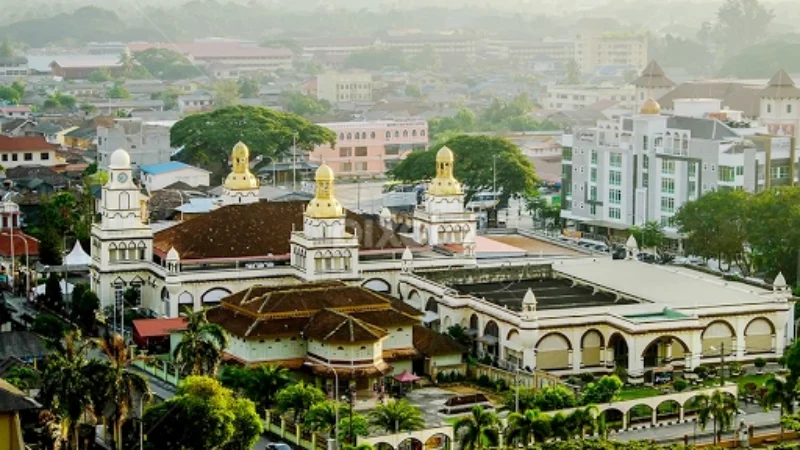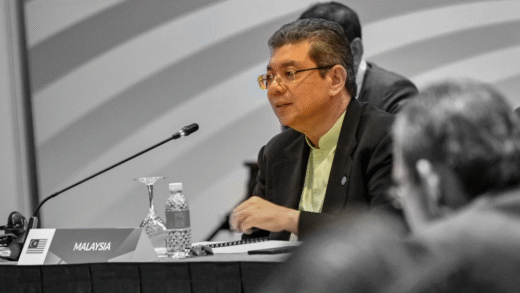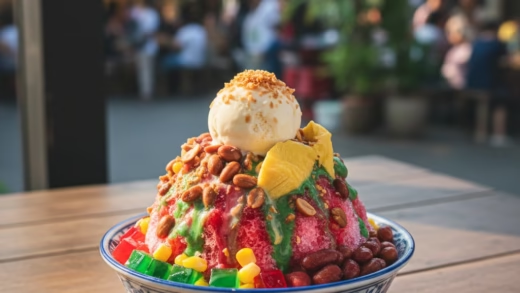Masjid Muhammadi Kota Bharu – The Majestic State Mosque of Kelantan

Introduction
Nestled in the heart of Kota Bharu, Masjid Muhammadi stands as a proud symbol of Kelantan’s deep Islamic heritage. Known as the State Mosque of Kelantan Darul Naim, this grand structure was originally built in 1867 during the reign of Sultan Muhammad II. Over the centuries, it has evolved from a humble wooden structure into a magnificent stone mosque — representing both spiritual devotion and architectural brilliance.
History of Masjid Muhammadi
Masjid Muhammadi’s story begins in 1867, when it was first constructed using selected timber. This early mosque served as a cornerstone of faith and community life in Kelantan.
In 1922, the mosque underwent a major reconstruction, transforming it into a Western-style (British-influenced) stone building — a rare blend of Islamic and colonial design. The new structure was officially inaugurated on 31 July 1931 by KDYMM Sultan Ismail, and it was named Masjid Muhammadi in honor of Sultan Muhammad II.
Over the decades, several renovations were undertaken — in 1959, 1968, 1976, and 1987 — to expand the mosque’s capacity and preserve its architectural beauty. Today, Masjid Muhammadi spans 10,600 square feet and accommodates up to 2,400 worshippers at a time.
Architectural Highlights
Masjid Muhammadi is admired for its graceful combination of Islamic and colonial influences. Its striking façade features arched windows, domes, and elegant minarets that reflect a timeless aesthetic. The spacious prayer hall is fully air-conditioned, offering a serene environment for worshippers and visitors alike.
Its open layout creates a welcoming space for reflection, prayer, and community gatherings — making it one of the most visited mosques in Kelantan.
A Center of Islamic Scholarship
From the 1860s to the 1960s, Masjid Muhammadi was a leading Islamic educational centre in Malaysia. It attracted renowned scholars such as:
- Tok Kenali – a celebrated Kelantanese Islamic reformer
- Hj. Abdul Rahman Arab
- Hj. Wan Abdullah
- Sheikh Daud al-Fatoni
These scholars transformed Masjid Muhammadi into a respected institution of religious learning, where lessons in Quranic studies, tafsir, and Islamic law were taught. The mosque continues this tradition today through daily Quranic classes, dawn study sessions, and Maghrib lectures.
Spiritual and Community Hub
Each day, around 500 worshippers gather at Masjid Muhammadi, with numbers rising to 600 or more during the evening prayers. According to Imam Zulkiflee Mohamed, the mosque’s welcoming atmosphere, youth engagement programs, and central location contribute to its popularity.
The mosque hosts a range of religious and social activities, including Maulidur Rasul, Isra’ Mikraj, and Ramadan gatherings, reinforcing its role as the spiritual heart of Kelantan.
Masjid Muhammadi also holds a special connection with Sultan Muhammad V, who regularly performs prayers here — especially Maghrib and Isya — in an informal and humble manner, meeting citizens without royal protocol.
Location and Access
Address:
Masjid Muhammadi, D1, Bandar Kota Bharu, Kota Bharu, Kelantan, Malaysia
Located at the city centre, the mosque is easily accessible by public transport, taxi, or on foot. Its proximity to popular attractions like Siti Khadijah Market, Istana Jahar, and Kelantan State Museum makes it a must-visit stop for both locals and tourists.
Visiting Information
- Open Hours: Open daily (non-Muslims may visit outside prayer times)
- Dress Code: Modest attire required
- Facilities: Prayer halls, lecture areas, air conditioning, public rest areas
- Managed by: The Islamic Religious Council and Malay Customs of Kelantan
Cultural Importance
Beyond being a religious landmark, Masjid Muhammadi is a powerful symbol of unity, learning, and devotion in Kelantan. It stands as a reminder of Malaysia’s enduring Islamic identity, preserving traditions while embracing modernity. Its serene ambiance and historical depth continue to draw worshippers, scholars, and travelers from around the world.
FAQs about Masjid Muhammadi
Q1: When was Masjid Muhammadi built?
Masjid Muhammadi was originally built in 1867 and reconstructed as a stone mosque in 1922.
Q2: Who inaugurated the new mosque structure?
It was inaugurated on 31 July 1931 by KDYMM Sultan Ismail.
Q3: What is the mosque’s capacity?
The mosque can accommodate approximately 2,400 worshippers.
Q4: Can tourists visit Masjid Muhammadi?
Yes, non-Muslim visitors are welcome outside of prayer times, provided they dress modestly and act respectfully.
Q5: Why is Masjid Muhammadi significant?
It is the official State Mosque of Kelantan, an iconic Islamic educational centre, and a historical monument reflecting the faith and culture of the people of Kelantan.
Conclusion
Masjid Muhammadi remains a timeless testament to Kelantan’s religious devotion, cultural heritage, and architectural grace. From its humble wooden beginnings to its grand colonial-era reconstruction, this mosque continues to inspire generations of believers and visitors alike. Whether you seek spiritual peace, architectural beauty, or historical insight, Masjid Muhammadi in Kota Bharu stands as a radiant beacon of Malaysia’s Islamic legacy.















Comments are closed.